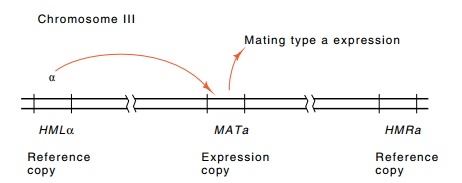Chapter: Genetics and Molecular Biology: Regulation of Mating Type in Yeast
Mating Type Conversion in Saccharomyces cerevisiae
Mating Type Conversion in Saccharomyces cerevisiae
Yeast possessing the ho allele switch from mating type MATa, to MATα or vice versa at a frequency of about 10-6 per
doubling time, whereas yeast possessing the HO
allele, the form most commonly found in nature, switch mating types as
frequently as once each generation.
As in the study of many biological phenomena, the
study of mutants revealed hidden details of the mating-type system. Saccharomyces mat-ing-type mutants
showed an astonishing fact. If an ho
strain which is MATα-, making it defective in mating, is switched to MATa and thenswitched back to MATα, the original defect, the MATα- mutation, disap

New MATα- mutations can be isolated in the
healed strain, and these too heal upon mating-type switching. The only
reasonable conclusion is the one first postulated by

Figure
16.2 Reference and expression copies
of yeast mating-type genes. Inthis example α mating type information is being copied from HMLα to MAT to switch the a
mating type cell to α mating type.
Oshima and Takano–that the cells contain
nonexpressed reference copies of the MATa
and MATα information on the chromosome in addition to the expressible forms of MATa or MATα information. The reference sites
are named HML and HMR, and the expression site is named MAT (Fig. 16.2). Usually, but not
always, HML contains α mating-type information, and HMR contains a type
information. As explained below, direct physical data have confirmed this
conclusion.
Related Topics